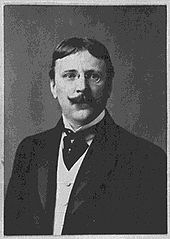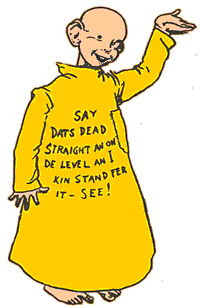
Richard F. Outcault
Encyclopedia

The Yellow Kid
The Yellow Kid emerged as the lead character in Hogan's Alley, drawn by Richard F. Outcault, which became one of the first Sunday supplement comic strips in an American newspaper, although its graphical layout had already been thoroughly established in political and other, purely-for-entertainment...
and Buster Brown
Buster Brown
Buster Brown was a comic strip character created in 1902 by Richard Felton Outcault who was known for his association with the Brown Shoe Company. This mischievous young boy was loosely based on a boy near Outcault's home in Flushing, New York...
, and he is considered the inventor of the modern comic strip
Comic strip
A comic strip is a sequence of drawings arranged in interrelated panels to display brief humor or form a narrative, often serialized, with text in balloons and captions....
.
Early life
Born in Lancaster, OhioLancaster, Ohio
Lancaster is a city in Fairfield County, Ohio, United States. As of the 2010 census, the city population was 38,780. It is located near the Hocking River, approximately southeast of Columbus, Ohio. It is the county seat of Fairfield County...
, Outcault was 15 years old when he went to Cincinnati and enrolled in the McMicken University’s School of Design where he studied for three years.
Career
After graduation, Outcault was employed by Thomas EdisonThomas Edison
Thomas Alva Edison was an American inventor and businessman. He developed many devices that greatly influenced life around the world, including the phonograph, the motion picture camera, and a long-lasting, practical electric light bulb. In addition, he created the world’s first industrial...
as a technical illustrator, going to Paris
Paris
Paris is the capital and largest city in France, situated on the river Seine, in northern France, at the heart of the Île-de-France region...
as the official artist for Edison’s traveling exhibit of electric lighting. In 1890, he moved to New York City
New York City
New York is the most populous city in the United States and the center of the New York Metropolitan Area, one of the most populous metropolitan areas in the world. New York exerts a significant impact upon global commerce, finance, media, art, fashion, research, technology, education, and...
, where he joined Electrical World (a magazine owned by one of Edison’s friends) and became a regular contributor to Truth magazine, Judge and Life.


Joseph Pulitzer
Joseph Pulitzer April 10, 1847 – October 29, 1911), born Politzer József, was a Hungarian-American newspaper publisher of the St. Louis Post Dispatch and the New York World. Pulitzer introduced the techniques of "new journalism" to the newspapers he acquired in the 1880s and became a leading...
New York World
New York World
The New York World was a newspaper published in New York City from 1860 until 1931. The paper played a major role in the history of American newspapers...
, Pulitzer placed Outcault's comics in a color supplement
Supplement (publishing)
A supplement is a publication that has a role secondary to that of another preceding or concurrent publication.A follow-on publication complements its predecessor, either by bringing it up-to-date , or by otherwise enhancing the predecessor's coverage of a particular topic or subject matter, as in...
, using a single-panel color cartoon
Cartoon
A cartoon is a form of two-dimensional illustrated visual art. While the specific definition has changed over time, modern usage refers to a typically non-realistic or semi-realistic drawing or painting intended for satire, caricature, or humor, or to the artistic style of such works...
on the front page called Hogan's Alley, depicting an event in a fictional slum. A character in the panel, The Yellow Kid
The Yellow Kid
The Yellow Kid emerged as the lead character in Hogan's Alley, drawn by Richard F. Outcault, which became one of the first Sunday supplement comic strips in an American newspaper, although its graphical layout had already been thoroughly established in political and other, purely-for-entertainment...
, gave rise to the phrase "yellow journalism
Yellow journalism
Yellow journalism or the yellow press is a type of journalism that presents little or no legitimate well-researched news and instead uses eye-catching headlines to sell more newspapers. Techniques may include exaggerations of news events, scandal-mongering, or sensationalism...
." Hogan's Alley debuted May 5, 1895.
In October 1896, Outcault defected to William Randolph Hearst's
William Randolph Hearst
William Randolph Hearst was an American business magnate and leading newspaper publisher. Hearst entered the publishing business in 1887, after taking control of The San Francisco Examiner from his father...
New York Journal. The result of a lawsuit awarded the title "Hogan's Alley" to the World and "The Yellow Kid
The Yellow Kid
The Yellow Kid emerged as the lead character in Hogan's Alley, drawn by Richard F. Outcault, which became one of the first Sunday supplement comic strips in an American newspaper, although its graphical layout had already been thoroughly established in political and other, purely-for-entertainment...
" to the Journal.
In 1902, Outcault introduced Buster Brown
Buster Brown
Buster Brown was a comic strip character created in 1902 by Richard Felton Outcault who was known for his association with the Brown Shoe Company. This mischievous young boy was loosely based on a boy near Outcault's home in Flushing, New York...
, a mischievous boy dressed in Little Lord Fauntleroy
Little Lord Fauntleroy
Little Lord Fauntleroy is the first children's novel written by English playwright and author Frances Hodgson Burnett. It was originally published as a serial in the St. Nicholas Magazine between November 1885 and October 1886, then as a book by Scribner's in 1886...
style, and his dog Tige. The strip and characters were very popular, and Outcault eventually licensed the name for a number of consumer products, notably Buster Brown shoes.
In the Journal, Outcault began experimenting with using multiple panels and speech balloons. Although he was not the first to use either technique, his use of them created the standard by which comics were measured.
Death
Richard F. Outcault died in 1928 in Flushing, New York. He was interred in the Forest Lawn Memorial Park Cemetery in Glendale, CaliforniaGlendale, California
Glendale is a city in Los Angeles County, California, United States. As of the 2010 Census, the city population is 191,719, down from 194,973 at the 2000 census. making it the third largest city in Los Angeles County and the 22nd largest city in the state of California...
.

